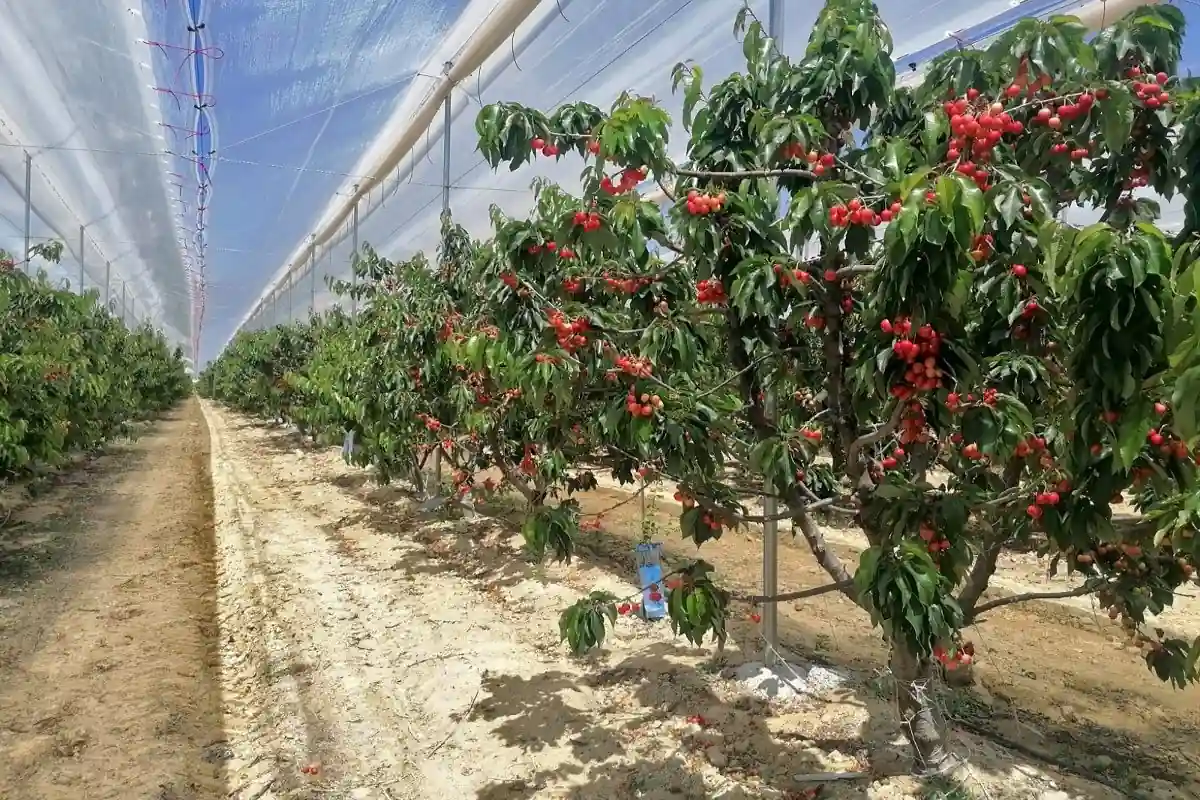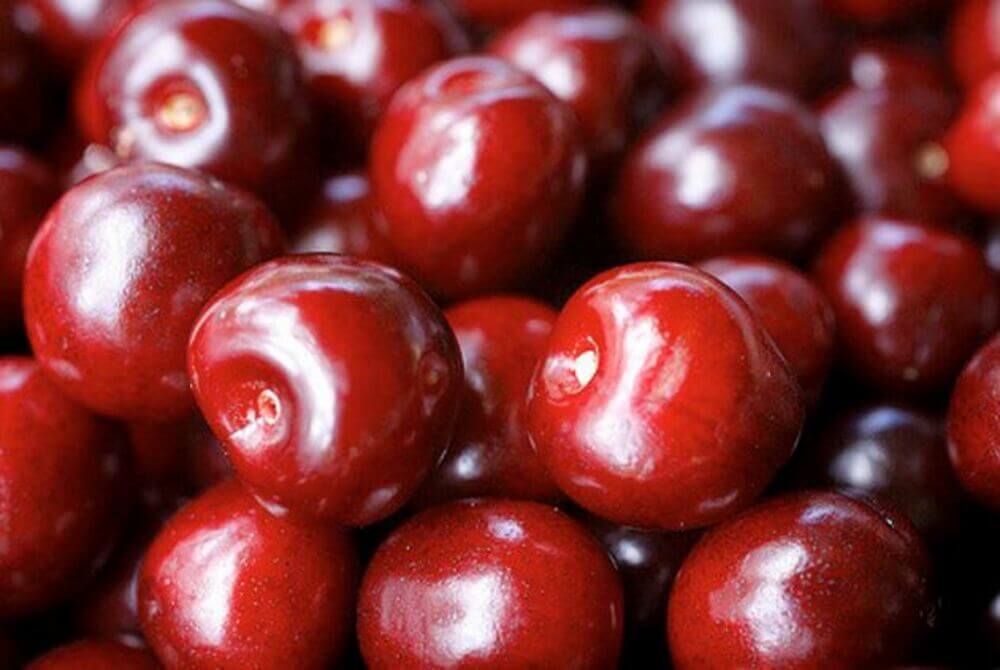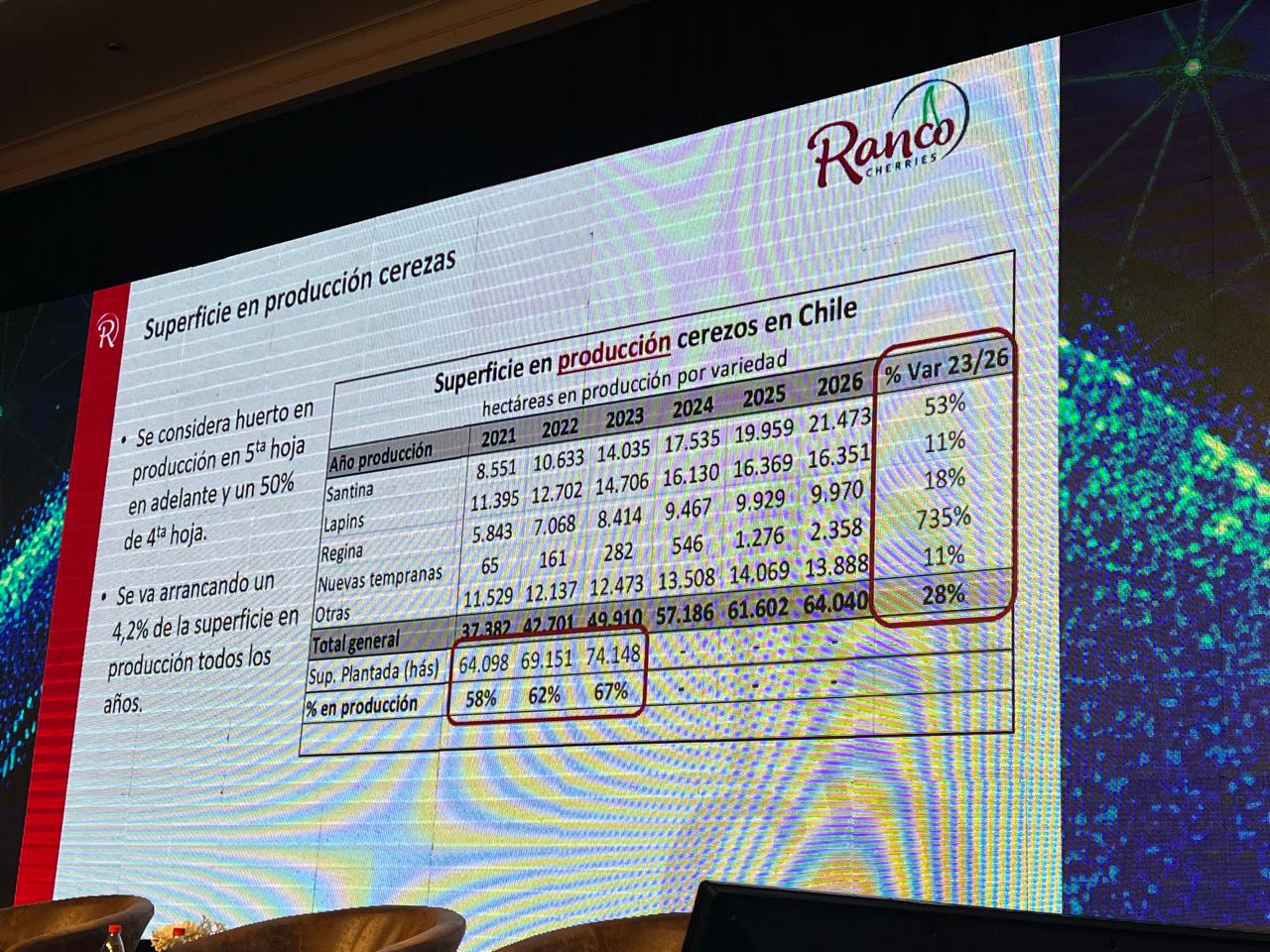When it comes to cherry production, being early is no longer enough: you need to be ultra-early.
In this interview, Spanish grower and expert consultant in macrotunnel production, Javier De Pablo, analyzes some of the current challenges and those that producers will have to face in order to obtain firm and early cherries under cover, in a context where certain varieties and coverings are aimed at being the earliest possible.
After 23 years of working with plastic covers in orchards, Javier De Pablo knows the needs and requirements of farmers and exporters. And, of course, which structures best suit a crop like cherries.
Because, as this Spaniard who grows early cherries under macrotunnels in Aragon, Spain, states, it’s not just about covering an orchard for the sake of it—this technology makes it possible to obtain cherries of the quality demanded by the market. And even if the markets are just a few kilometers away in Spain, these structures are also used in Chile, allowing for higher-quality cherries for export.
 Image 1. De Pablo family orchard in Aragon, Spain.
Image 1. De Pablo family orchard in Aragon, Spain.
The Chilean experience
After a first visit to Chile six years ago, he noticed a significant change in the country’s agricultural landscape, especially in cherry-producing areas. “Today we see significant areas equipped with technology. I see more and more surfaces with plastic covers,” says the consultant, who now splits his time between Spain, Chile, Portugal, France, Uzbekistan, and Azerbaijan.
“At first, I thought it was for rain protection, as is usually the case in Chile with plastic coverings that open and close with some difficulty because they’re not very agile. But then I saw that in many other farms, with the constant planting of orchards, especially of Santina, and because the commercialization window is not expanding, people also wanted to advance their production,” he explains.
However, he warns: “It’s very difficult to advance production with rain covers, because they’re not designed for that or not equipped to both anticipate and ensure quality.”
Despite this, he notes that Chilean companies are now offering more alternatives, such as roof vents “which ventilate quite well,” as well as trials with automated rain systems that are well underway and could be key to maintaining agility in the orchard.
The advantages of macrotunnels
– In this sense, macrotunnels are different.
– The introduction of macrotunnels is something else entirely. Inside there’s a greater volume of air, which gives us more heating capacity, but also allows for faster cooling, as they usually have automated windows. This is key to producing quality.
– Many experts recommend that early areas should consolidate production with covers to advance even further…
– Plastic is a necessary evil. It shouldn’t be over the cherries, especially before harvest. But it must be there when there’s a risk of rain, and you must be agile in opening it. If you’re not quick after rain, the moisture stays trapped, creating a sauna effect, resulting in soft cherries. For us in Spain, it’s a relative problem because we sell fruit locally or nearby (France, Italy, or the UK). But in Chile, it’s a serious issue, because anything not shipped by air has to endure a 25–30 day journey (40,000–48,000 km).
– Is speed of handling the main difference between a rain cover and a macrotunnel?
– The main difference is that rain systems are not agile. A grower with a large area needs many people and several days to close when rain is coming and to reopen afterward. Instead, with macrotunnels, you can automate window openings with a button in a matter of minutes per hectare, without personnel. This lets you produce the type of cherry Chile needs.
 Image 2. Macrotunnel with orchard in bloom.
Image 2. Macrotunnel with orchard in bloom.
Risks and plastic management
– What are the strengths and weaknesses of these systems? The heat build-up under plastic also increases the risk of softening or disease…
– One of the threats is obviously fungal diseases. There’s higher relative humidity, especially during flowering and post-flowering. Specific treatments are needed. But honestly, I see it as a minor issue, because in Chile they’re extremely rigorous with treatments. If I recommend a treatment, within minutes I have ten tractor drivers ready.
From this point of view, Chile is well prepared. What worries me more is the firmness of the cherry. I think this is where mistakes have been made—also in Spain. Cherries under plastic are softer and less suitable for travel. But another thing is knowing how to build greenhouses with openable roofs, which brings you closer to open-field conditions and lets you enjoy the benefits of greenhouse protection early in the cycle, until the stone hardening stage. At that point, excess heat and humidity aren’t critical, as the cherry can’t absorb ambient moisture yet and won’t soften.
After that point, the structure should remain open, except during rain, and you must act quickly. That’s the weakness: many macrotunnels and rain systems have been built without ensuring agility after rain or during stone hardening.
– This was evident in Chile this year, with protests from receivers about soft fruit…
– I was in Chile this season. There was a rain forecast, so everyone closed the covers as a precaution. Producers had invested and needed to avoid fruit cracking.
Climate strategy and automation
But then it stopped raining, and the forecast the next day only suggested possible rain. That’s where the hard decision lies: if you don’t open, you’ll get soft cherries. But if you do and it rains, they’ll crack. That’s why rain systems are not agile: fear makes you keep them closed, because you’ve come so far and don’t want to risk it. But a macrotunnel can be automated. The idea is to keep the orchard ventilated as long as it’s not raining—because I want firm cherries. That’s the key and the weakness of plastic: soft cherries.
Plastic reduces light and adds more heat and humidity than needed. These three factors combined during ripening lead to soft cherries.
– How do you plan or manage the movement of covers, considering it’s a low-agility system when not automated?
– You need to be clear about a couple of points: before flowering and until stone hardening, the cherry tree doesn’t need much light. Heat is more important to advance the cycle. But once you pass the hardening stage, the opposite is true: heat becomes excessive, plastic blocks light, and humidity increases significantly. At that point, the cover should always be open, unless it rains.
– How do the covers behave in case of frost?
– That’s a strategy issue: when to place the plastic and when the tree starts to wake up. It’s one thing if chilling hours are completed—then you can remove the net or place plastic and proceed.
But be careful: if you’re in a low-frost area, fine, you can advance flowering by a month. But if you’re in a high-frost area, even with enough chilling, be cautious with bud break—advancing the phenological cycle by a month can make the cherry tree vulnerable during frost.
If you push too far—say, flowering in August in Chile—the greenhouse won’t help much, because radiation is low and can’t warm the soil. The soil cools quickly, leading to long hours of low temps and frost risk. September changes everything: ambient temperatures rise, soil warms and retains heat at night, giving more margin and less risk. Forget August: the greenhouse won’t save you from frost if you advance too much. From then on, it can help in light frosts from -1°C to -3°C.
 Image 3. Orchard in Murcia, Spain, with early varieties under plastic.
Image 3. Orchard in Murcia, Spain, with early varieties under plastic.
Technology and early production
– How important is it for an early producer to have covers?
– I’m in a mid-season area in Spain, not an early one. When I started 23 years ago, there were no early areas—low-chill varieties didn’t exist, and nobody knew what a cherry greenhouse was. If we managed to advance by 15 days, it was enough—I was alone on the market.
And the early-zone varieties that could compete with me were poor quality, very soft. But that has changed a lot. Now there are early areas with low-chill varieties and even earlier regions than mine, with enough chill and firmer varieties. The same could happen in Chile. Early will always be early, and with a little help—a greenhouse, a macrotunnel, or another structure—it will always have an advantage.
But mid-season growers will end up on the market alongside early varieties with good firmness. That’s why it makes sense to install technology in early zones and improve production further. In early areas, you need the structure first for shading—because if you stand to gain a lot, you can’t risk lacking chill—and then for heating. You only need plastic for a short time: to advance the early cycle, then remove it and only put it back in case of rain.
– Can macrotunnels adapt to different regions and climates?
– When continuous tunnels are built, where one tunnel post supports the next and there’s a gutter between, it’s very risky, because heavy rain can load many kilos all at once, especially if structures are light. That happened to us in Spain with snow—it piled up in the gutter, crushed the plastic, and destroyed the structure. In Chile, I’ve seen macrotunnels with channels between structures to prevent water from falling inside the greenhouse—which would raise humidity—but that requires much stronger posts. Everything’s possible, but it must be anticipated and well designed.
Text and image source: Redagricola
Miguel Patino
Redagricola
Cherry Times – All rights reserved















